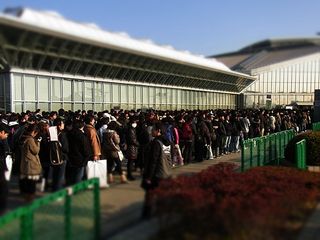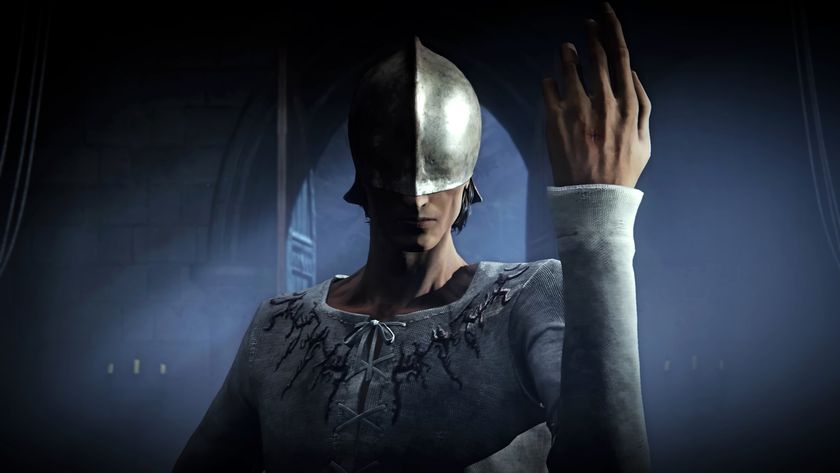Plus Alpha: Comiket 81
Swimming through the crowds at Japan’s Comic Market

Plus Alpha is a weekly column that explores life in Japan from the perspective of American expatriate and game-industry veteran Jarik Sikat. Having worked in numerous areas of the game industry since 1994, Sikat relocated to Japan in 2010.
Frustrated with the state of existing manga fan events and the narrow focus of mainstream publications at the time, a small group or “circle” of manga creators started Comiket or “Comic Market,” a non-profit venue where artists and creators could showcase their work, exchange ideas and support each other’s creative endeavors. The first Comiket held in the December of 1975 drew 32 “circles” and attracted 700 attendees.

Today, the three-day event that is held at the Tokyo Big Site convention center is the world’s largest of its kind, hosting 35,000 circles and approximately 500,000 fans. Admission is free, and it is open to the public. The show’s official guidebook is nearly two inches thick. In comparison, the 2010 San Diego Comic-Con International drew roughly 130,000 attendees over its four-day show.
Originally staged as a marketplace for “doujinshi,” which include self-published magazines and books featuring the original works of the group involved, Comiket explains in its promotional materials that the self-publishing groups or “doujinshi circles” aren’t in it for profit. For them doujinshi is a tool for self-expression. However, the Otaku boom in the Japanese mainstream has fueled major changes to the show. Participating sellers now include companies such as Sega, Aniplex, and TBS (Tokyo Broadcasting System).

Above: Lines for the corporate hall
Having regularly attended AnimeExpo, Fanime, WonderCon, Tokyo Game Show and E3, I consider myself a con vet, but this was my first-ever Comiket.
Although the event starts at 10am, the official Comiket website advises first-timers to come in the afternoon, mainly to avoid the long lines getting in. That’s exactly what we did. While we didn’t have to wait to enter Tokyo Big Site, we did get caught in an endless flow of otaku swelling from Kokusaitenjijou train station all the way into the core of the complex, as we were funneled through a closely-monitored labyrinth of roped-off channels.
Sign up to the GamesRadar+ Newsletter
Weekly digests, tales from the communities you love, and more
Nearly everywhere there are volunteers kindly reminding you to keep moving. On a second level overpass I could see the cosplay area below, however signs strictly forbade photography from above. I tried to sneak a shot for you guys, but Haruhi Suzumiya (or at least a volunteer cosplaying as her) bullhorned a kind reminder that I shouldn’t be standing still.

Above: A section of the doujinshi area
The doujinshi area is a football field’s worth of manga. The artist talent was incredible, but given the time we had it was just too big to casually browse through, so we pushed ahead to the corporate hall. Along the way there were additional signs that urged show-goers not to use mobile phones or portable game devices while walking.
On that note I’m happy to report there were no fan-made signs, and absolutely no incidents of “glomping”.
December was perhaps the better time to attend the biannual event, as the temperature high was 48F on the day we went. The August show will have you sweltering in the upper 80’s and you also have to contend with Tokyo’s drenching humidity.
Vending machines (“jidouhanbaiki”) and convenience stores (“conbini”) are scattered throughout the facility, but you might want to bring a camelback or thermos. You can freely enter between the halls, but if you wanted to purchase something from one of the more popular corporate booths, you may need to queue up in one of the countless lines outside. There’s no telling how long you’ll have to wait, but we saw at least one fan pass out from exhaustion.
One of the more interesting things I noticed is that when line groups were escorted into the hall, each person would march in with one hand raised above their head. I was told this was to deter line jumpers.

Above: A small sampling of love pillows
Back inside, if you love cute, doe-eyed “moe” (pronounced mo-eh) characters, this is the place for you. There was little to see in the way of mechs, ninjas or pirates. Over at the Sega booth, the blue-haired sensation and vocaloid superstar Hatsune Miku was the main draw. Across the way, a company polled attendees on their favorite schoolgirl character. If you’re like James Franco, you’ll be happy to know “love pillow” pillow cases emblazoned with life-sized drawings of moe girls were everywhere. The ones with girls in more “compromising” poses had band-aids temporarily hiding the more risqué parts.
Bring lots of cash or none at all should you want to resist temptation. A hoodie embroidered with a character from the anime series K-ON! cost 12,600 yen (US$172) while some T-shirts were still steep at 6,300 yen (US$86).
It was difficult to soak up the event in the few hours we had. I’m already looking forward to the next Comiket, with better stamina to handle the crowds. The show’s official homepage offers a complete list of survival tips in English, but if you’ve been to Comiket or any of the other big cons, please feel free to share some of yours in the comments.
Jarik Sikat has worked in the videogame industry in areas ranging from localization and product development to public relations and marketing. As a freelance journalist and writer, his work has appeared in PlayStation: The Official Magazine, Official Xbox Magazine and Newtype USA.

Nintendo of America president Doug Bowser says FromSoftware's The Duskbloods is evidence of Hidetaka Miyazaki's faith in the Switch 2 hardware

Former PlayStation exec Shuhei Yoshida gives the Switch 2 Direct a 7/10, and he says it would be even lower if FromSoftware didn't show up with The Duskbloods











